Business Law and Ethics: Negligence Case Study - Duty of Care Analysis
VerifiedAdded on 2020/05/16
|10
|2107
|88
Case Study
AI Summary
This case study examines a scenario involving ATV Adventures and the negligence of its sole trader, Josh Marsh, towards a client, Wajiha. The analysis identifies two key issues: Josh's negligence and Wajiha's entitlement to damages. The study applies legal principles from cases like Grant v Australian Knitting Mills and Donoghue v Stevenson, focusing on the elements of negligence: duty of care (assessed using the Caparo test), breach of duty, causation (using the 'but for' test), and remoteness of damage. The application section details how Josh breached his duty of care by providing faulty equipment and taking a dangerous route, leading to Wajiha's injuries. The analysis also considers contributory negligence, as Wajiha did not wear knee guards as instructed. The conclusion finds Josh negligent but notes that Wajiha's damages would be reduced due to her contributory negligence. The case study provides a detailed application of legal principles to a real-world business scenario, offering a comprehensive understanding of negligence law.
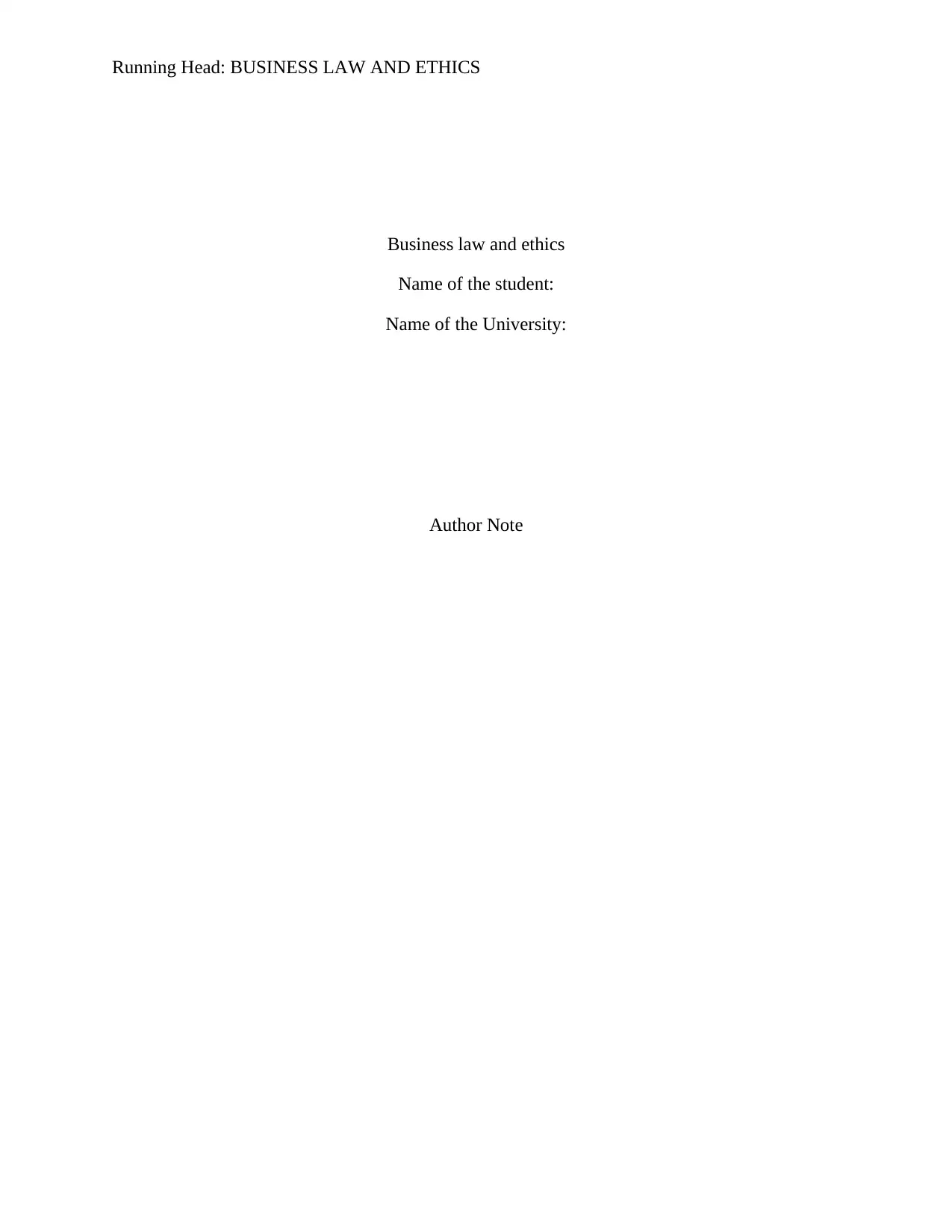
Running Head: BUSINESS LAW AND ETHICS
Business law and ethics
Name of the student:
Name of the University:
Author Note
Business law and ethics
Name of the student:
Name of the University:
Author Note
Paraphrase This Document
Need a fresh take? Get an instant paraphrase of this document with our AI Paraphraser
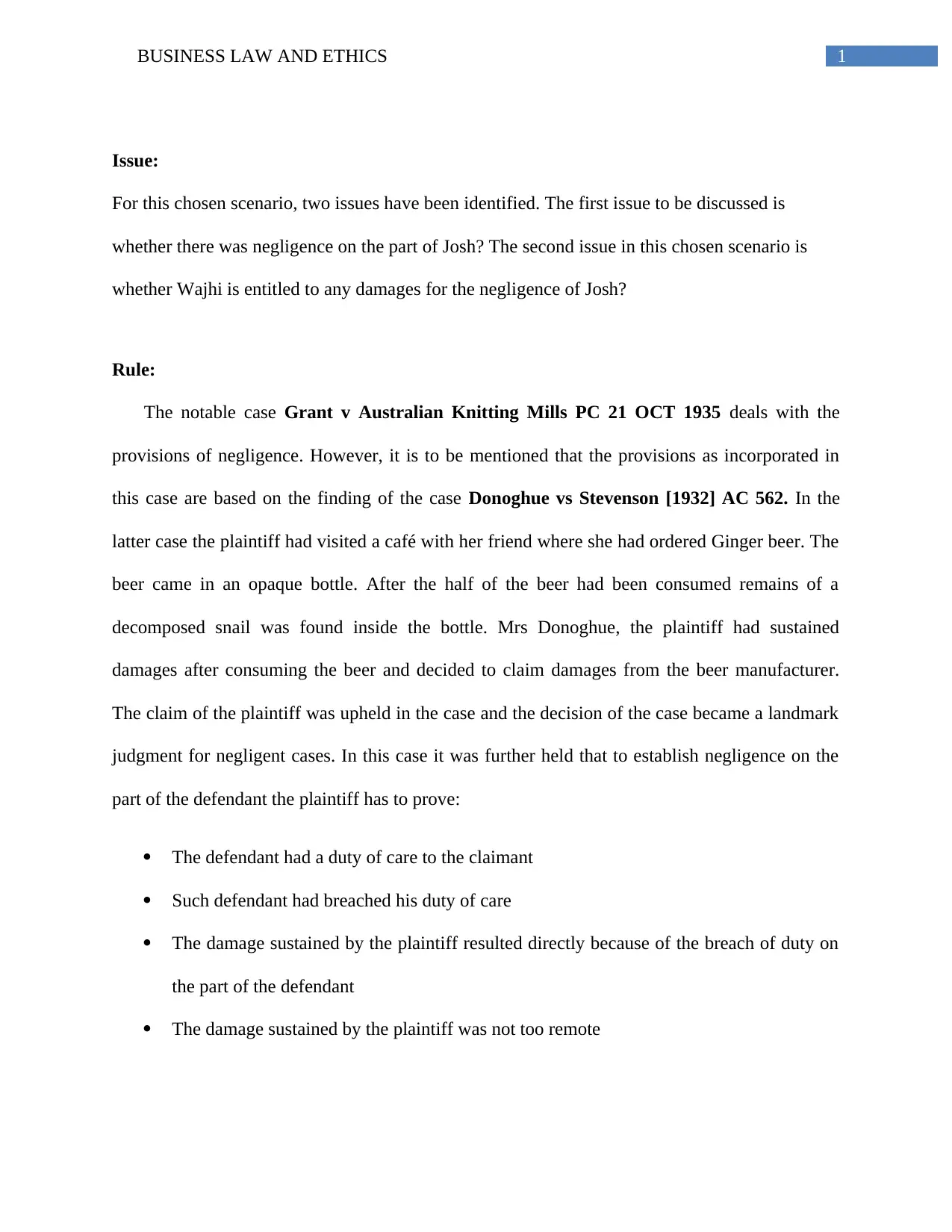
1BUSINESS LAW AND ETHICS
Issue:
For this chosen scenario, two issues have been identified. The first issue to be discussed is
whether there was negligence on the part of Josh? The second issue in this chosen scenario is
whether Wajhi is entitled to any damages for the negligence of Josh?
Rule:
The notable case Grant v Australian Knitting Mills PC 21 OCT 1935 deals with the
provisions of negligence. However, it is to be mentioned that the provisions as incorporated in
this case are based on the finding of the case Donoghue vs Stevenson [1932] AC 562. In the
latter case the plaintiff had visited a café with her friend where she had ordered Ginger beer. The
beer came in an opaque bottle. After the half of the beer had been consumed remains of a
decomposed snail was found inside the bottle. Mrs Donoghue, the plaintiff had sustained
damages after consuming the beer and decided to claim damages from the beer manufacturer.
The claim of the plaintiff was upheld in the case and the decision of the case became a landmark
judgment for negligent cases. In this case it was further held that to establish negligence on the
part of the defendant the plaintiff has to prove:
The defendant had a duty of care to the claimant
Such defendant had breached his duty of care
The damage sustained by the plaintiff resulted directly because of the breach of duty on
the part of the defendant
The damage sustained by the plaintiff was not too remote
Issue:
For this chosen scenario, two issues have been identified. The first issue to be discussed is
whether there was negligence on the part of Josh? The second issue in this chosen scenario is
whether Wajhi is entitled to any damages for the negligence of Josh?
Rule:
The notable case Grant v Australian Knitting Mills PC 21 OCT 1935 deals with the
provisions of negligence. However, it is to be mentioned that the provisions as incorporated in
this case are based on the finding of the case Donoghue vs Stevenson [1932] AC 562. In the
latter case the plaintiff had visited a café with her friend where she had ordered Ginger beer. The
beer came in an opaque bottle. After the half of the beer had been consumed remains of a
decomposed snail was found inside the bottle. Mrs Donoghue, the plaintiff had sustained
damages after consuming the beer and decided to claim damages from the beer manufacturer.
The claim of the plaintiff was upheld in the case and the decision of the case became a landmark
judgment for negligent cases. In this case it was further held that to establish negligence on the
part of the defendant the plaintiff has to prove:
The defendant had a duty of care to the claimant
Such defendant had breached his duty of care
The damage sustained by the plaintiff resulted directly because of the breach of duty on
the part of the defendant
The damage sustained by the plaintiff was not too remote
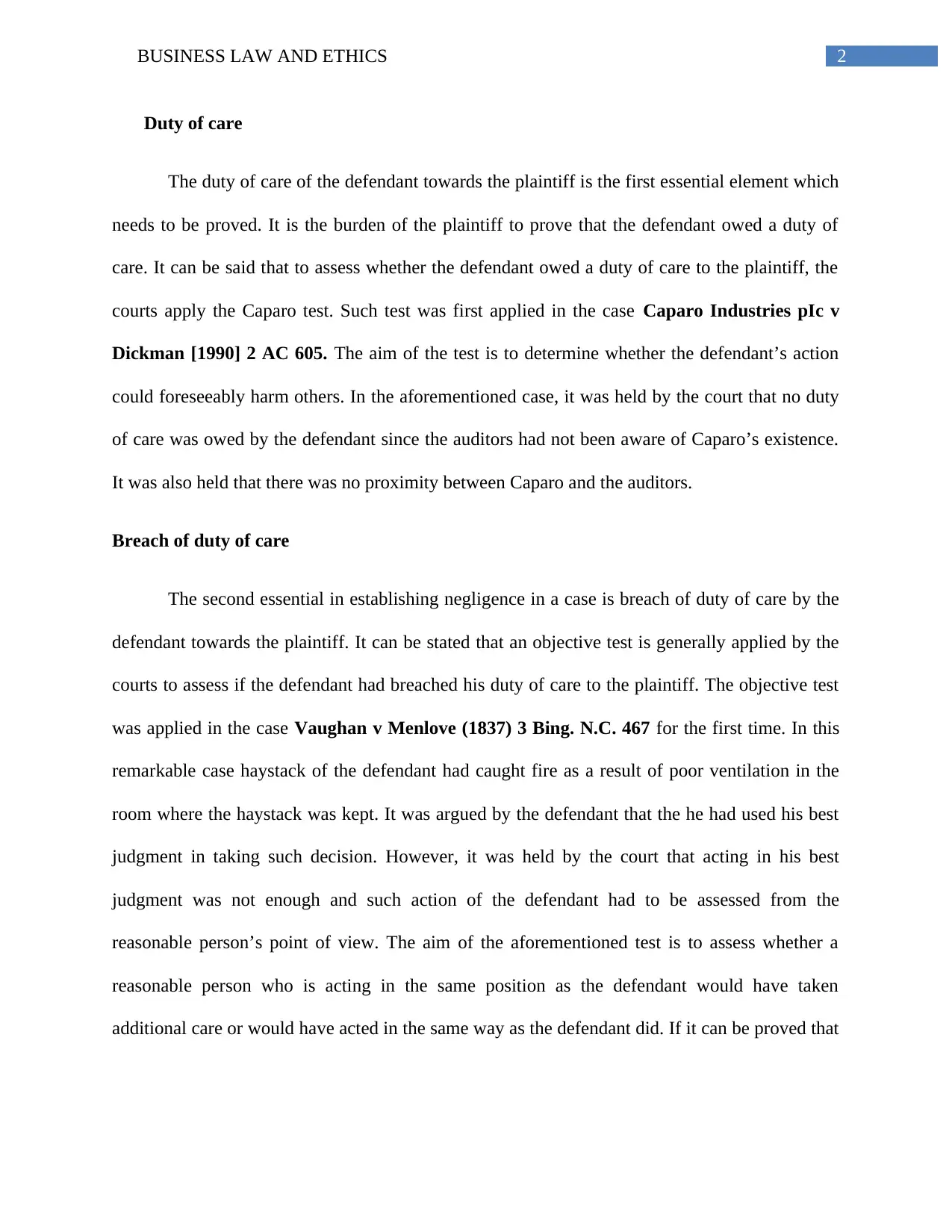
2BUSINESS LAW AND ETHICS
Duty of care
The duty of care of the defendant towards the plaintiff is the first essential element which
needs to be proved. It is the burden of the plaintiff to prove that the defendant owed a duty of
care. It can be said that to assess whether the defendant owed a duty of care to the plaintiff, the
courts apply the Caparo test. Such test was first applied in the case Caparo Industries pIc v
Dickman [1990] 2 AC 605. The aim of the test is to determine whether the defendant’s action
could foreseeably harm others. In the aforementioned case, it was held by the court that no duty
of care was owed by the defendant since the auditors had not been aware of Caparo’s existence.
It was also held that there was no proximity between Caparo and the auditors.
Breach of duty of care
The second essential in establishing negligence in a case is breach of duty of care by the
defendant towards the plaintiff. It can be stated that an objective test is generally applied by the
courts to assess if the defendant had breached his duty of care to the plaintiff. The objective test
was applied in the case Vaughan v Menlove (1837) 3 Bing. N.C. 467 for the first time. In this
remarkable case haystack of the defendant had caught fire as a result of poor ventilation in the
room where the haystack was kept. It was argued by the defendant that the he had used his best
judgment in taking such decision. However, it was held by the court that acting in his best
judgment was not enough and such action of the defendant had to be assessed from the
reasonable person’s point of view. The aim of the aforementioned test is to assess whether a
reasonable person who is acting in the same position as the defendant would have taken
additional care or would have acted in the same way as the defendant did. If it can be proved that
Duty of care
The duty of care of the defendant towards the plaintiff is the first essential element which
needs to be proved. It is the burden of the plaintiff to prove that the defendant owed a duty of
care. It can be said that to assess whether the defendant owed a duty of care to the plaintiff, the
courts apply the Caparo test. Such test was first applied in the case Caparo Industries pIc v
Dickman [1990] 2 AC 605. The aim of the test is to determine whether the defendant’s action
could foreseeably harm others. In the aforementioned case, it was held by the court that no duty
of care was owed by the defendant since the auditors had not been aware of Caparo’s existence.
It was also held that there was no proximity between Caparo and the auditors.
Breach of duty of care
The second essential in establishing negligence in a case is breach of duty of care by the
defendant towards the plaintiff. It can be stated that an objective test is generally applied by the
courts to assess if the defendant had breached his duty of care to the plaintiff. The objective test
was applied in the case Vaughan v Menlove (1837) 3 Bing. N.C. 467 for the first time. In this
remarkable case haystack of the defendant had caught fire as a result of poor ventilation in the
room where the haystack was kept. It was argued by the defendant that the he had used his best
judgment in taking such decision. However, it was held by the court that acting in his best
judgment was not enough and such action of the defendant had to be assessed from the
reasonable person’s point of view. The aim of the aforementioned test is to assess whether a
reasonable person who is acting in the same position as the defendant would have taken
additional care or would have acted in the same way as the defendant did. If it can be proved that
⊘ This is a preview!⊘
Do you want full access?
Subscribe today to unlock all pages.

Trusted by 1+ million students worldwide
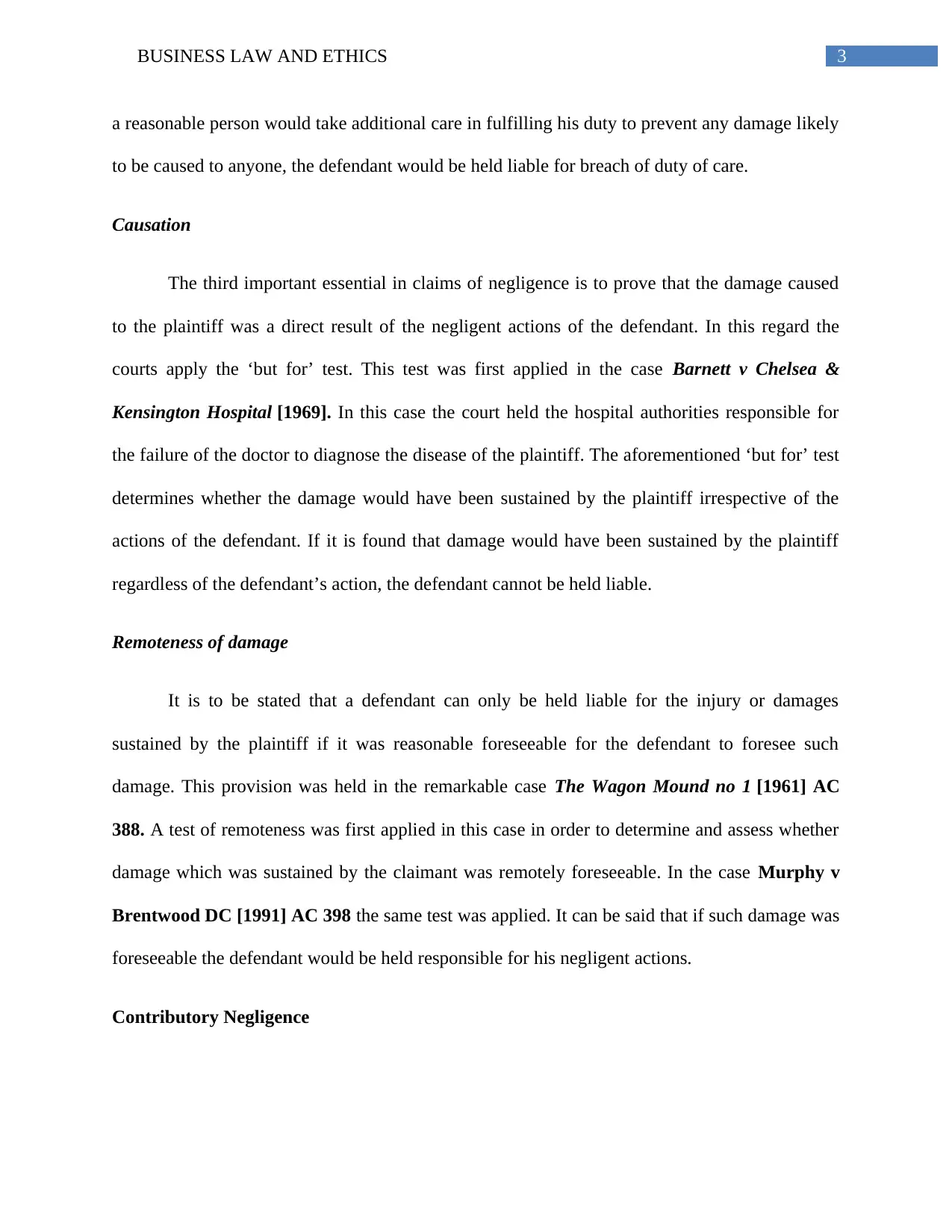
3BUSINESS LAW AND ETHICS
a reasonable person would take additional care in fulfilling his duty to prevent any damage likely
to be caused to anyone, the defendant would be held liable for breach of duty of care.
Causation
The third important essential in claims of negligence is to prove that the damage caused
to the plaintiff was a direct result of the negligent actions of the defendant. In this regard the
courts apply the ‘but for’ test. This test was first applied in the case Barnett v Chelsea &
Kensington Hospital [1969]. In this case the court held the hospital authorities responsible for
the failure of the doctor to diagnose the disease of the plaintiff. The aforementioned ‘but for’ test
determines whether the damage would have been sustained by the plaintiff irrespective of the
actions of the defendant. If it is found that damage would have been sustained by the plaintiff
regardless of the defendant’s action, the defendant cannot be held liable.
Remoteness of damage
It is to be stated that a defendant can only be held liable for the injury or damages
sustained by the plaintiff if it was reasonable foreseeable for the defendant to foresee such
damage. This provision was held in the remarkable case The Wagon Mound no 1 [1961] AC
388. A test of remoteness was first applied in this case in order to determine and assess whether
damage which was sustained by the claimant was remotely foreseeable. In the case Murphy v
Brentwood DC [1991] AC 398 the same test was applied. It can be said that if such damage was
foreseeable the defendant would be held responsible for his negligent actions.
Contributory Negligence
a reasonable person would take additional care in fulfilling his duty to prevent any damage likely
to be caused to anyone, the defendant would be held liable for breach of duty of care.
Causation
The third important essential in claims of negligence is to prove that the damage caused
to the plaintiff was a direct result of the negligent actions of the defendant. In this regard the
courts apply the ‘but for’ test. This test was first applied in the case Barnett v Chelsea &
Kensington Hospital [1969]. In this case the court held the hospital authorities responsible for
the failure of the doctor to diagnose the disease of the plaintiff. The aforementioned ‘but for’ test
determines whether the damage would have been sustained by the plaintiff irrespective of the
actions of the defendant. If it is found that damage would have been sustained by the plaintiff
regardless of the defendant’s action, the defendant cannot be held liable.
Remoteness of damage
It is to be stated that a defendant can only be held liable for the injury or damages
sustained by the plaintiff if it was reasonable foreseeable for the defendant to foresee such
damage. This provision was held in the remarkable case The Wagon Mound no 1 [1961] AC
388. A test of remoteness was first applied in this case in order to determine and assess whether
damage which was sustained by the claimant was remotely foreseeable. In the case Murphy v
Brentwood DC [1991] AC 398 the same test was applied. It can be said that if such damage was
foreseeable the defendant would be held responsible for his negligent actions.
Contributory Negligence
Paraphrase This Document
Need a fresh take? Get an instant paraphrase of this document with our AI Paraphraser
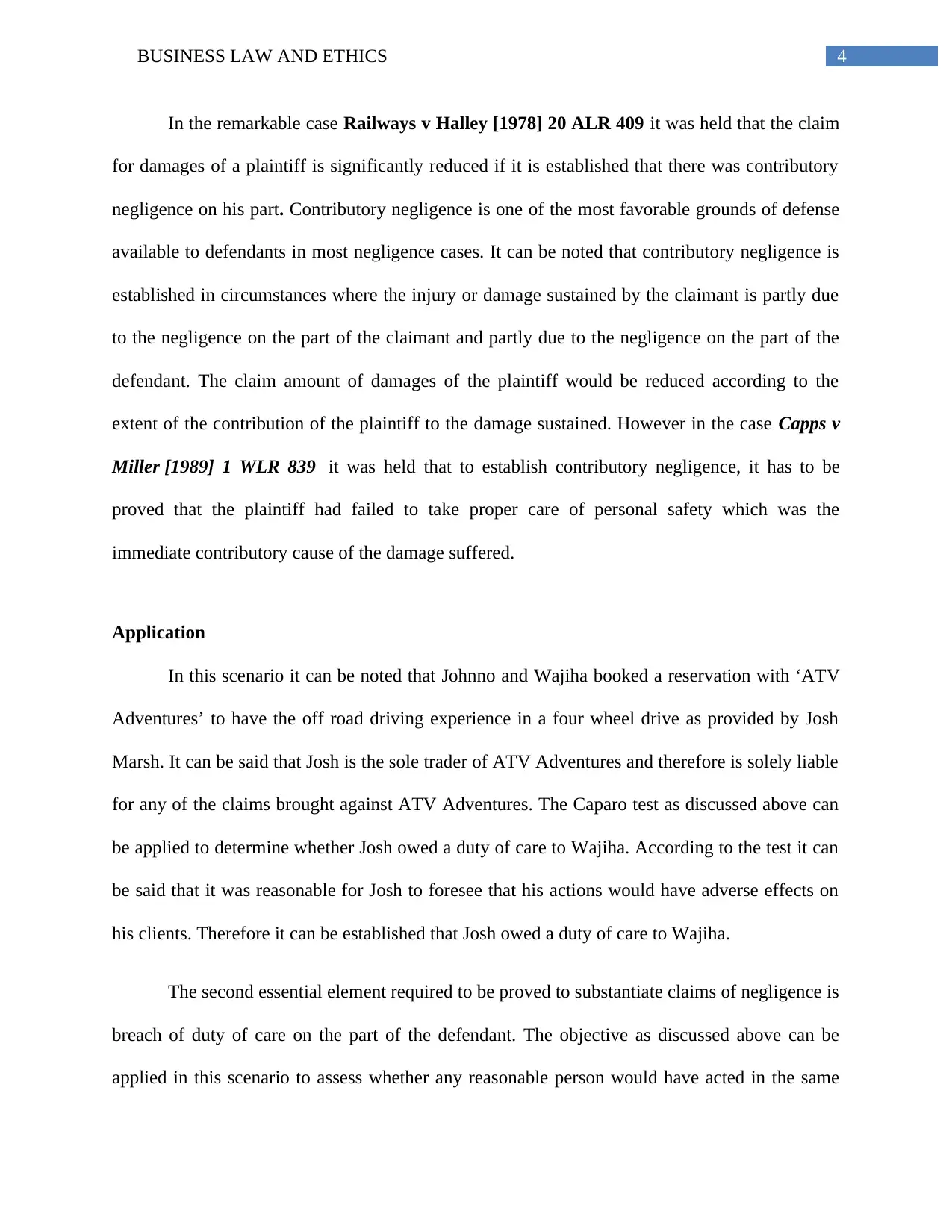
4BUSINESS LAW AND ETHICS
In the remarkable case Railways v Halley [1978] 20 ALR 409 it was held that the claim
for damages of a plaintiff is significantly reduced if it is established that there was contributory
negligence on his part. Contributory negligence is one of the most favorable grounds of defense
available to defendants in most negligence cases. It can be noted that contributory negligence is
established in circumstances where the injury or damage sustained by the claimant is partly due
to the negligence on the part of the claimant and partly due to the negligence on the part of the
defendant. The claim amount of damages of the plaintiff would be reduced according to the
extent of the contribution of the plaintiff to the damage sustained. However in the case Capps v
Miller [1989] 1 WLR 839 it was held that to establish contributory negligence, it has to be
proved that the plaintiff had failed to take proper care of personal safety which was the
immediate contributory cause of the damage suffered.
Application
In this scenario it can be noted that Johnno and Wajiha booked a reservation with ‘ATV
Adventures’ to have the off road driving experience in a four wheel drive as provided by Josh
Marsh. It can be said that Josh is the sole trader of ATV Adventures and therefore is solely liable
for any of the claims brought against ATV Adventures. The Caparo test as discussed above can
be applied to determine whether Josh owed a duty of care to Wajiha. According to the test it can
be said that it was reasonable for Josh to foresee that his actions would have adverse effects on
his clients. Therefore it can be established that Josh owed a duty of care to Wajiha.
The second essential element required to be proved to substantiate claims of negligence is
breach of duty of care on the part of the defendant. The objective as discussed above can be
applied in this scenario to assess whether any reasonable person would have acted in the same
In the remarkable case Railways v Halley [1978] 20 ALR 409 it was held that the claim
for damages of a plaintiff is significantly reduced if it is established that there was contributory
negligence on his part. Contributory negligence is one of the most favorable grounds of defense
available to defendants in most negligence cases. It can be noted that contributory negligence is
established in circumstances where the injury or damage sustained by the claimant is partly due
to the negligence on the part of the claimant and partly due to the negligence on the part of the
defendant. The claim amount of damages of the plaintiff would be reduced according to the
extent of the contribution of the plaintiff to the damage sustained. However in the case Capps v
Miller [1989] 1 WLR 839 it was held that to establish contributory negligence, it has to be
proved that the plaintiff had failed to take proper care of personal safety which was the
immediate contributory cause of the damage suffered.
Application
In this scenario it can be noted that Johnno and Wajiha booked a reservation with ‘ATV
Adventures’ to have the off road driving experience in a four wheel drive as provided by Josh
Marsh. It can be said that Josh is the sole trader of ATV Adventures and therefore is solely liable
for any of the claims brought against ATV Adventures. The Caparo test as discussed above can
be applied to determine whether Josh owed a duty of care to Wajiha. According to the test it can
be said that it was reasonable for Josh to foresee that his actions would have adverse effects on
his clients. Therefore it can be established that Josh owed a duty of care to Wajiha.
The second essential element required to be proved to substantiate claims of negligence is
breach of duty of care on the part of the defendant. The objective as discussed above can be
applied in this scenario to assess whether any reasonable person would have acted in the same
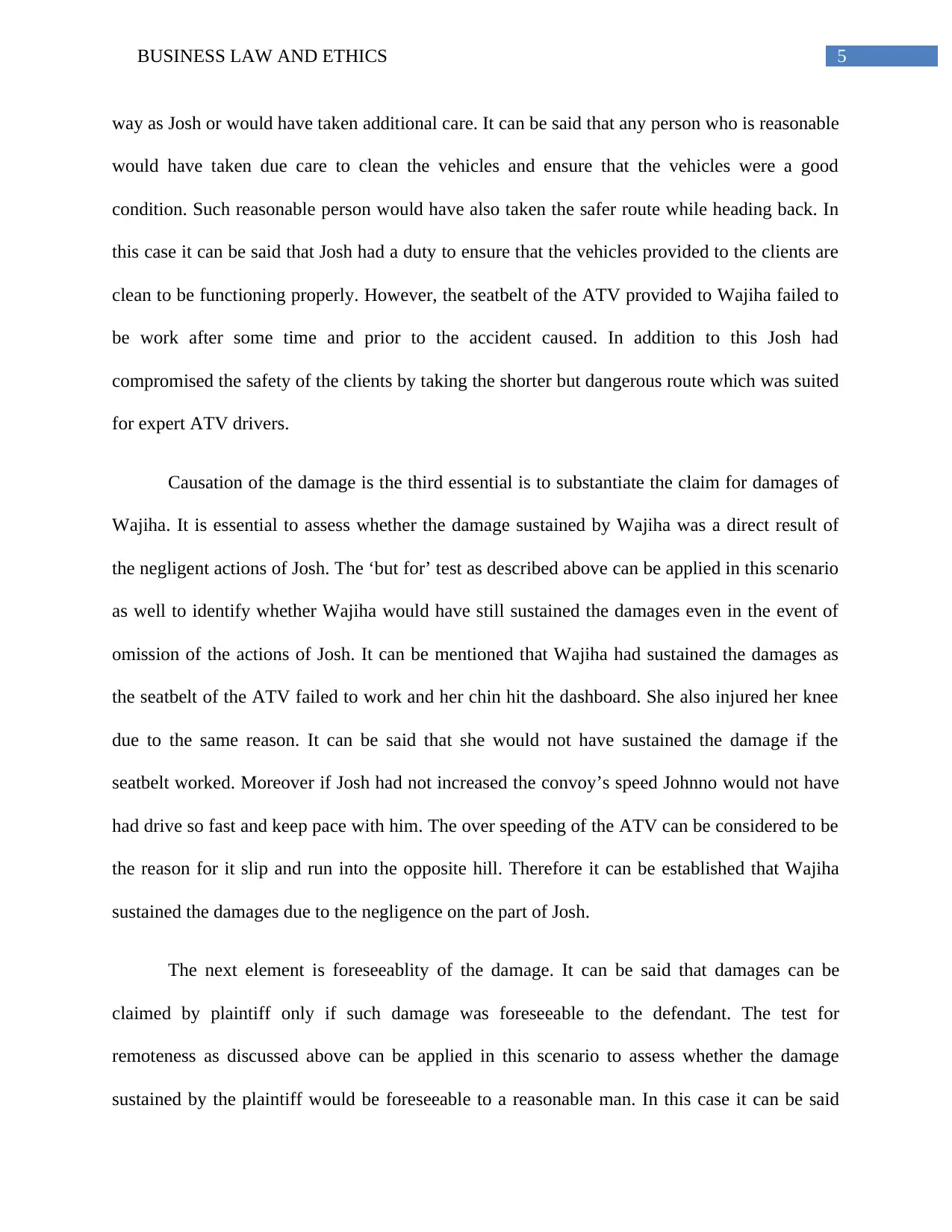
5BUSINESS LAW AND ETHICS
way as Josh or would have taken additional care. It can be said that any person who is reasonable
would have taken due care to clean the vehicles and ensure that the vehicles were a good
condition. Such reasonable person would have also taken the safer route while heading back. In
this case it can be said that Josh had a duty to ensure that the vehicles provided to the clients are
clean to be functioning properly. However, the seatbelt of the ATV provided to Wajiha failed to
be work after some time and prior to the accident caused. In addition to this Josh had
compromised the safety of the clients by taking the shorter but dangerous route which was suited
for expert ATV drivers.
Causation of the damage is the third essential is to substantiate the claim for damages of
Wajiha. It is essential to assess whether the damage sustained by Wajiha was a direct result of
the negligent actions of Josh. The ‘but for’ test as described above can be applied in this scenario
as well to identify whether Wajiha would have still sustained the damages even in the event of
omission of the actions of Josh. It can be mentioned that Wajiha had sustained the damages as
the seatbelt of the ATV failed to work and her chin hit the dashboard. She also injured her knee
due to the same reason. It can be said that she would not have sustained the damage if the
seatbelt worked. Moreover if Josh had not increased the convoy’s speed Johnno would not have
had drive so fast and keep pace with him. The over speeding of the ATV can be considered to be
the reason for it slip and run into the opposite hill. Therefore it can be established that Wajiha
sustained the damages due to the negligence on the part of Josh.
The next element is foreseeablity of the damage. It can be said that damages can be
claimed by plaintiff only if such damage was foreseeable to the defendant. The test for
remoteness as discussed above can be applied in this scenario to assess whether the damage
sustained by the plaintiff would be foreseeable to a reasonable man. In this case it can be said
way as Josh or would have taken additional care. It can be said that any person who is reasonable
would have taken due care to clean the vehicles and ensure that the vehicles were a good
condition. Such reasonable person would have also taken the safer route while heading back. In
this case it can be said that Josh had a duty to ensure that the vehicles provided to the clients are
clean to be functioning properly. However, the seatbelt of the ATV provided to Wajiha failed to
be work after some time and prior to the accident caused. In addition to this Josh had
compromised the safety of the clients by taking the shorter but dangerous route which was suited
for expert ATV drivers.
Causation of the damage is the third essential is to substantiate the claim for damages of
Wajiha. It is essential to assess whether the damage sustained by Wajiha was a direct result of
the negligent actions of Josh. The ‘but for’ test as described above can be applied in this scenario
as well to identify whether Wajiha would have still sustained the damages even in the event of
omission of the actions of Josh. It can be mentioned that Wajiha had sustained the damages as
the seatbelt of the ATV failed to work and her chin hit the dashboard. She also injured her knee
due to the same reason. It can be said that she would not have sustained the damage if the
seatbelt worked. Moreover if Josh had not increased the convoy’s speed Johnno would not have
had drive so fast and keep pace with him. The over speeding of the ATV can be considered to be
the reason for it slip and run into the opposite hill. Therefore it can be established that Wajiha
sustained the damages due to the negligence on the part of Josh.
The next element is foreseeablity of the damage. It can be said that damages can be
claimed by plaintiff only if such damage was foreseeable to the defendant. The test for
remoteness as discussed above can be applied in this scenario to assess whether the damage
sustained by the plaintiff would be foreseeable to a reasonable man. In this case it can be said
⊘ This is a preview!⊘
Do you want full access?
Subscribe today to unlock all pages.

Trusted by 1+ million students worldwide
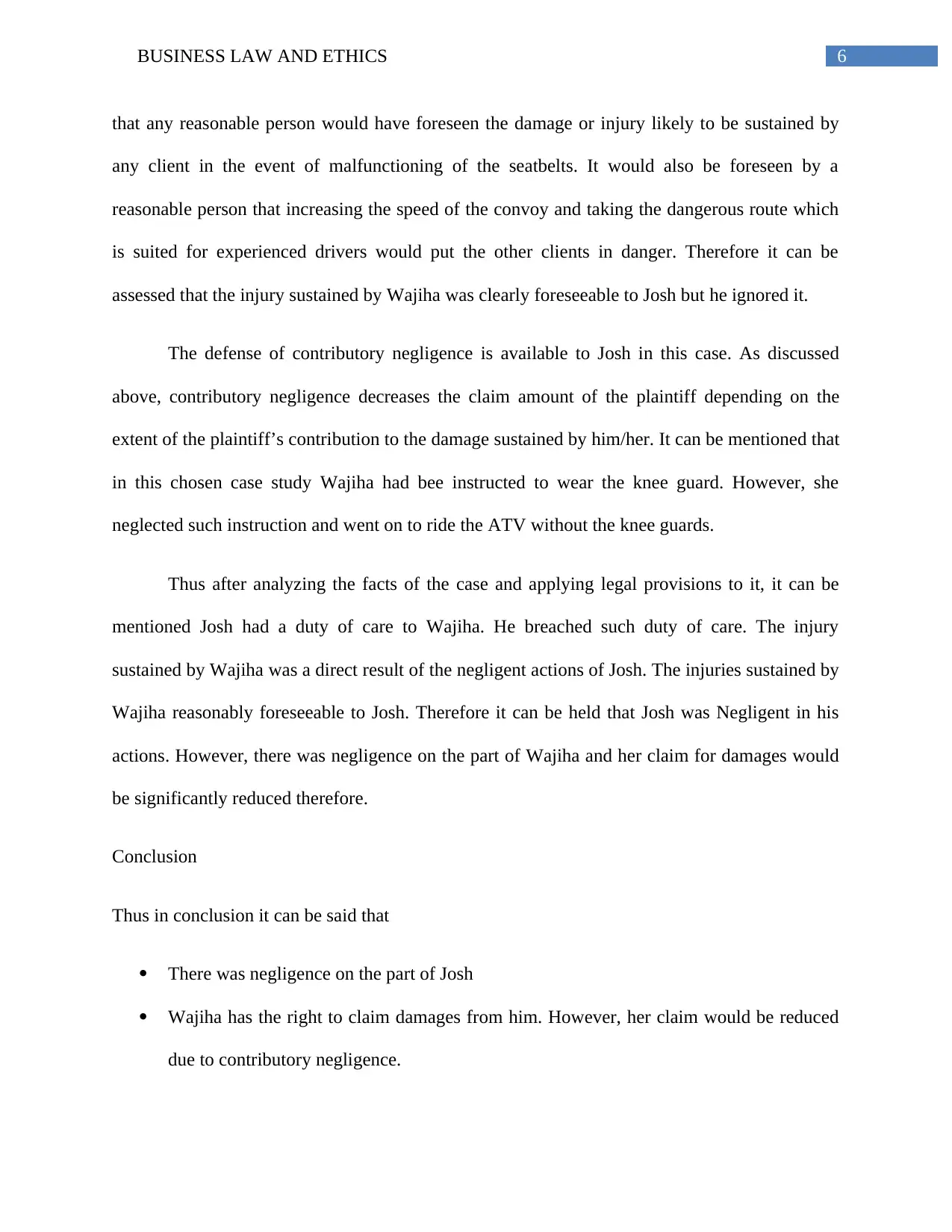
6BUSINESS LAW AND ETHICS
that any reasonable person would have foreseen the damage or injury likely to be sustained by
any client in the event of malfunctioning of the seatbelts. It would also be foreseen by a
reasonable person that increasing the speed of the convoy and taking the dangerous route which
is suited for experienced drivers would put the other clients in danger. Therefore it can be
assessed that the injury sustained by Wajiha was clearly foreseeable to Josh but he ignored it.
The defense of contributory negligence is available to Josh in this case. As discussed
above, contributory negligence decreases the claim amount of the plaintiff depending on the
extent of the plaintiff’s contribution to the damage sustained by him/her. It can be mentioned that
in this chosen case study Wajiha had bee instructed to wear the knee guard. However, she
neglected such instruction and went on to ride the ATV without the knee guards.
Thus after analyzing the facts of the case and applying legal provisions to it, it can be
mentioned Josh had a duty of care to Wajiha. He breached such duty of care. The injury
sustained by Wajiha was a direct result of the negligent actions of Josh. The injuries sustained by
Wajiha reasonably foreseeable to Josh. Therefore it can be held that Josh was Negligent in his
actions. However, there was negligence on the part of Wajiha and her claim for damages would
be significantly reduced therefore.
Conclusion
Thus in conclusion it can be said that
There was negligence on the part of Josh
Wajiha has the right to claim damages from him. However, her claim would be reduced
due to contributory negligence.
that any reasonable person would have foreseen the damage or injury likely to be sustained by
any client in the event of malfunctioning of the seatbelts. It would also be foreseen by a
reasonable person that increasing the speed of the convoy and taking the dangerous route which
is suited for experienced drivers would put the other clients in danger. Therefore it can be
assessed that the injury sustained by Wajiha was clearly foreseeable to Josh but he ignored it.
The defense of contributory negligence is available to Josh in this case. As discussed
above, contributory negligence decreases the claim amount of the plaintiff depending on the
extent of the plaintiff’s contribution to the damage sustained by him/her. It can be mentioned that
in this chosen case study Wajiha had bee instructed to wear the knee guard. However, she
neglected such instruction and went on to ride the ATV without the knee guards.
Thus after analyzing the facts of the case and applying legal provisions to it, it can be
mentioned Josh had a duty of care to Wajiha. He breached such duty of care. The injury
sustained by Wajiha was a direct result of the negligent actions of Josh. The injuries sustained by
Wajiha reasonably foreseeable to Josh. Therefore it can be held that Josh was Negligent in his
actions. However, there was negligence on the part of Wajiha and her claim for damages would
be significantly reduced therefore.
Conclusion
Thus in conclusion it can be said that
There was negligence on the part of Josh
Wajiha has the right to claim damages from him. However, her claim would be reduced
due to contributory negligence.
Paraphrase This Document
Need a fresh take? Get an instant paraphrase of this document with our AI Paraphraser
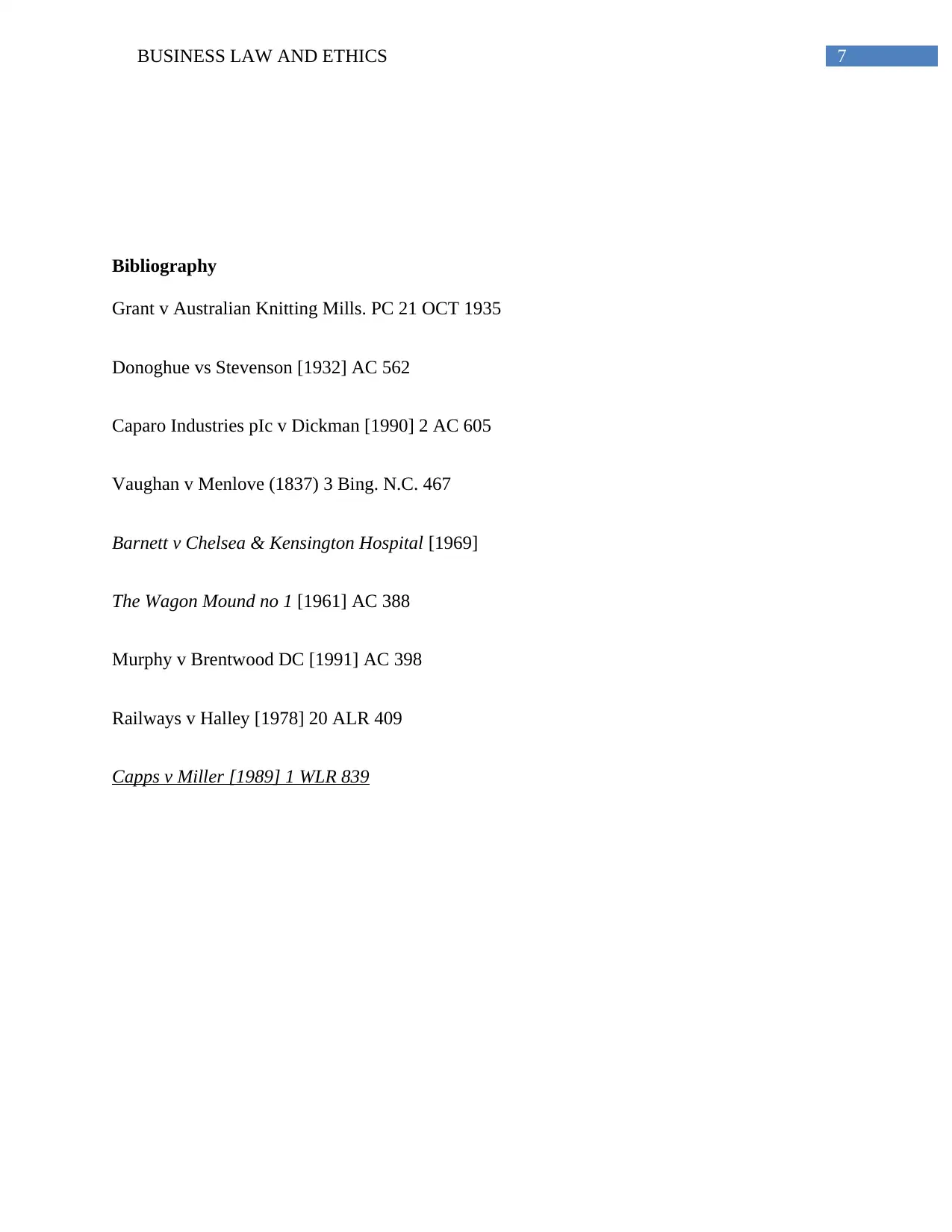
7BUSINESS LAW AND ETHICS
Bibliography
Grant v Australian Knitting Mills. PC 21 OCT 1935
Donoghue vs Stevenson [1932] AC 562
Caparo Industries pIc v Dickman [1990] 2 AC 605
Vaughan v Menlove (1837) 3 Bing. N.C. 467
Barnett v Chelsea & Kensington Hospital [1969]
The Wagon Mound no 1 [1961] AC 388
Murphy v Brentwood DC [1991] AC 398
Railways v Halley [1978] 20 ALR 409
Capps v Miller [1989] 1 WLR 839
Bibliography
Grant v Australian Knitting Mills. PC 21 OCT 1935
Donoghue vs Stevenson [1932] AC 562
Caparo Industries pIc v Dickman [1990] 2 AC 605
Vaughan v Menlove (1837) 3 Bing. N.C. 467
Barnett v Chelsea & Kensington Hospital [1969]
The Wagon Mound no 1 [1961] AC 388
Murphy v Brentwood DC [1991] AC 398
Railways v Halley [1978] 20 ALR 409
Capps v Miller [1989] 1 WLR 839
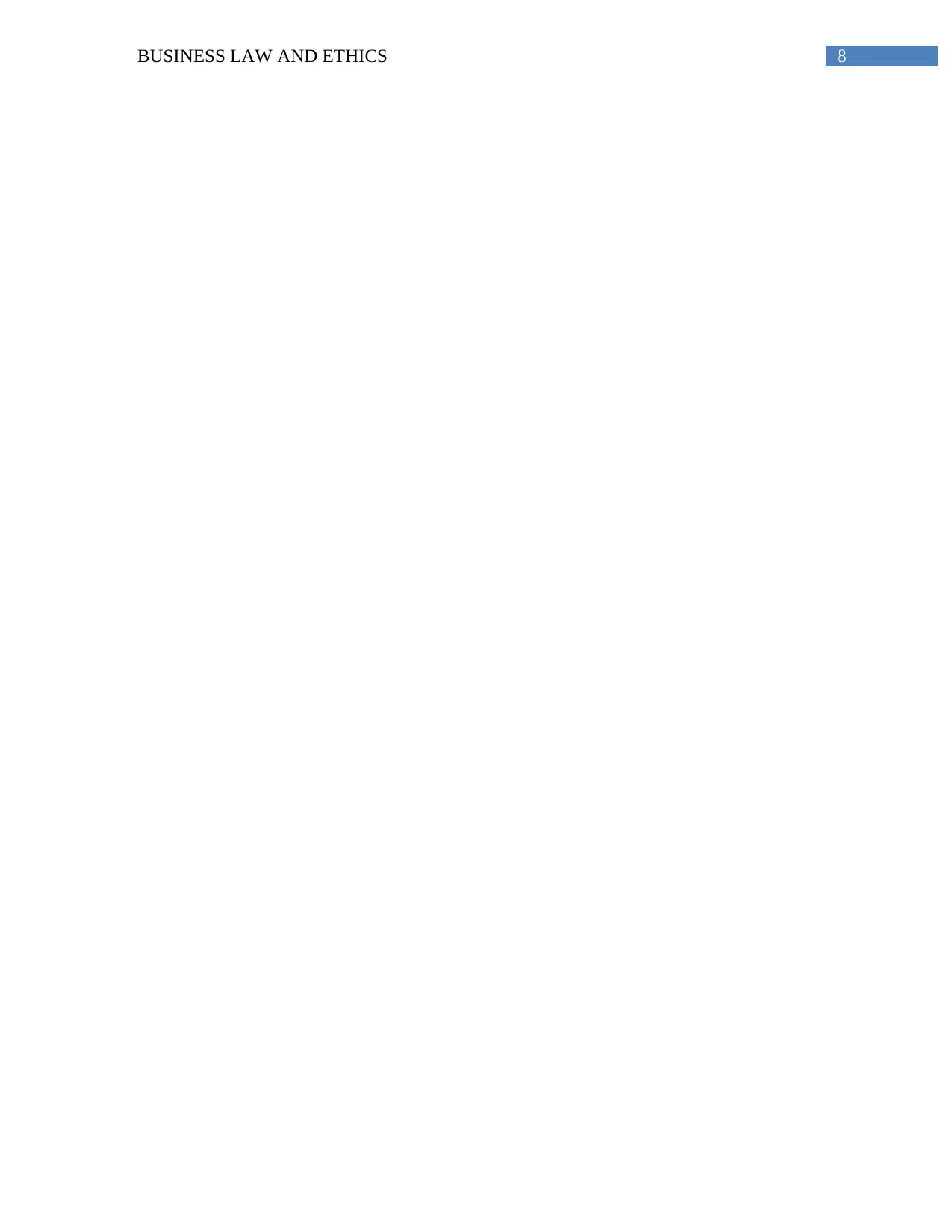
8BUSINESS LAW AND ETHICS
⊘ This is a preview!⊘
Do you want full access?
Subscribe today to unlock all pages.

Trusted by 1+ million students worldwide
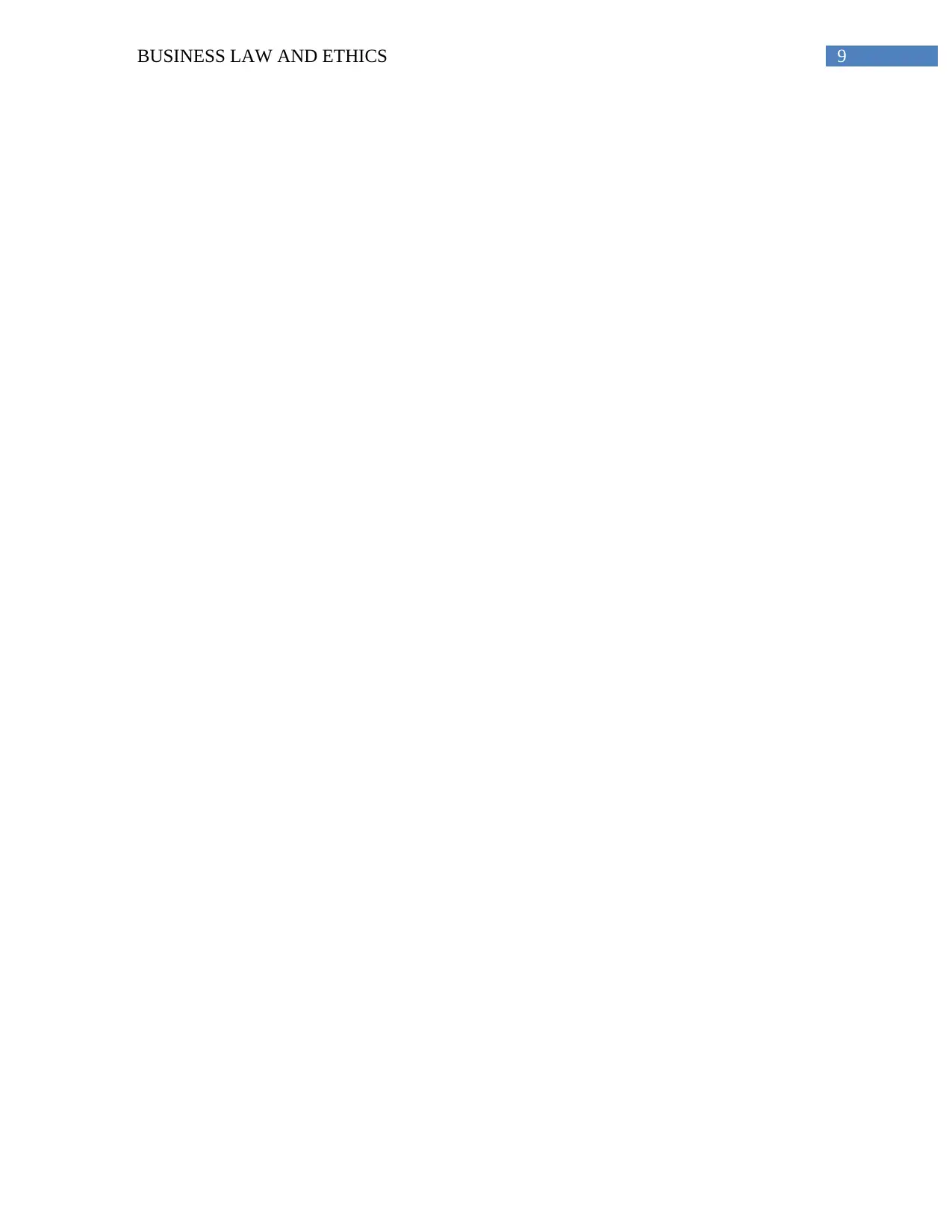
9BUSINESS LAW AND ETHICS
1 out of 10
Related Documents
Your All-in-One AI-Powered Toolkit for Academic Success.
+13062052269
info@desklib.com
Available 24*7 on WhatsApp / Email
![[object Object]](/_next/static/media/star-bottom.7253800d.svg)
Unlock your academic potential
Copyright © 2020–2025 A2Z Services. All Rights Reserved. Developed and managed by ZUCOL.





